.
14.12.2015
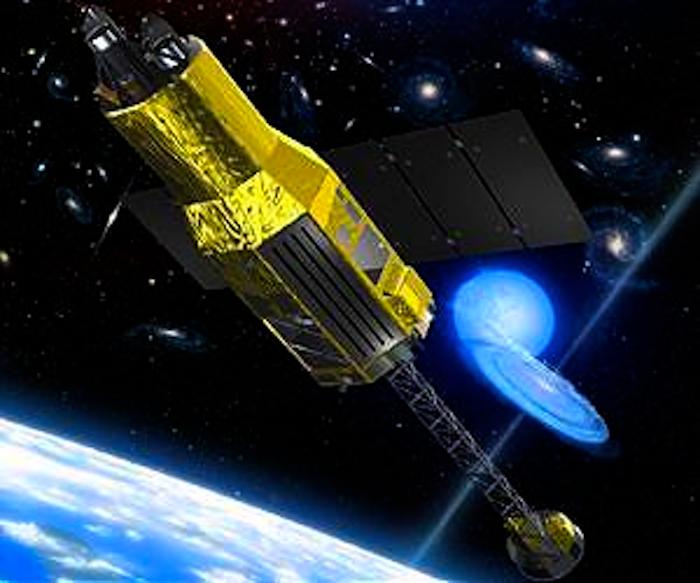
The ASTRO-H is an astronomy satellite to elucidate the structure of space and its evolution through studying high-temperature and high-energy celestial bodies, such as black holes, supernova remnants, and galaxy clusters by X-rays and gamma-rays.
.
Japan will launch an X-ray astronomy satellite atop an H-2A carrier rocket in February next year, as an effort to elucidate the structure of space and its evolution.
Mitsubishi Heavy Industries, Ltd. and the Japan Aerospace Exploration Agency (JAXA) announced Friday that they decided to launch the H-2A Launch Vehicle No.30 (H-2A F30) with the X-ray astronomy satellite "ASTRO-H" onboard on Feb.12, 2016 from Yoshinobu Launch Complex at the Tanegashima Space Center in Japan's southwestern Kagoshima prefecture.
"Launch time will be set for each launch day if the launch is delayed," said JAXA in a release. The launch window will be between Feb.13-29, 2016.
"To capitalize on the excess launch capability of the H-2A F30, we will also provide launch and orbit injection opportunities for small secondary payloads (piggyback payloads)," said the Japanese space agency.
The ASTRO-H is an astronomy satellite to elucidate the structure of space and its evolution through studying high-temperature and high-energy celestial bodies, such as black holes, supernova remnants, and galaxy clusters by X-rays and gamma-rays.
X-rays and gamma-rays from space are absorbed in the Earth's atmosphere, thus they cannot be observed on the Earth. Therefore observation in space is necessary.
The 14-meter-long ASTRO-H is the 6th Japanese-led X-ray observatory, and the successor to the Suzaku satellite which is currently in space.
Quelle: SD
-
Update: 20.12.2015
.
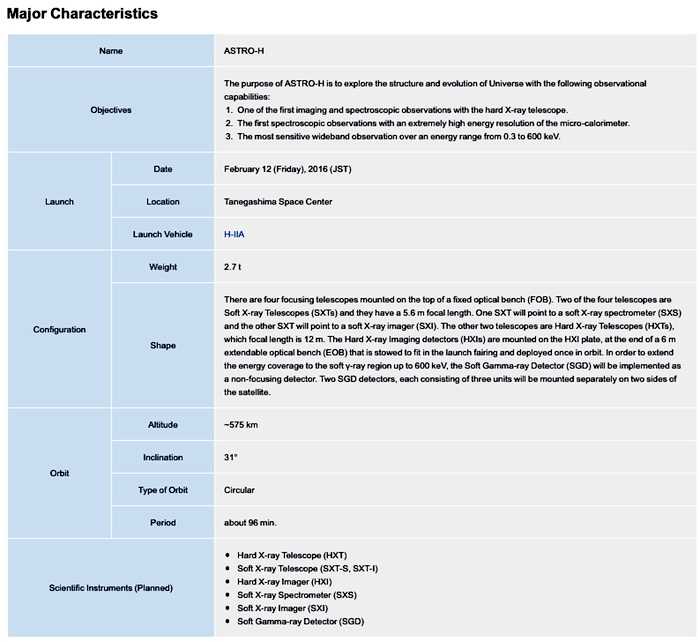
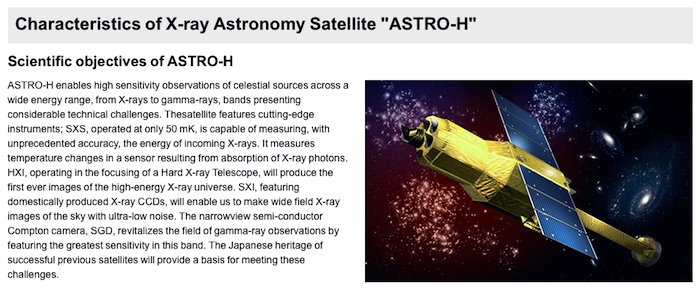
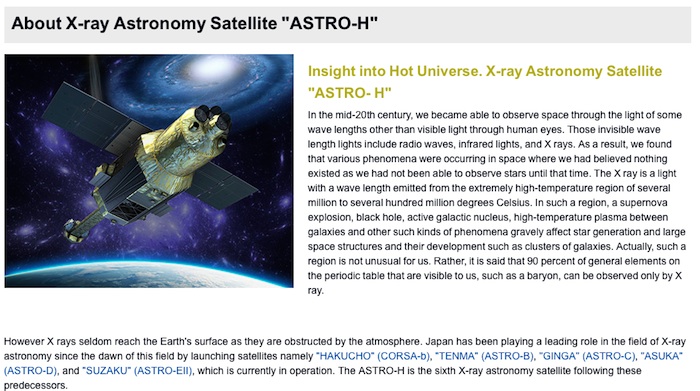
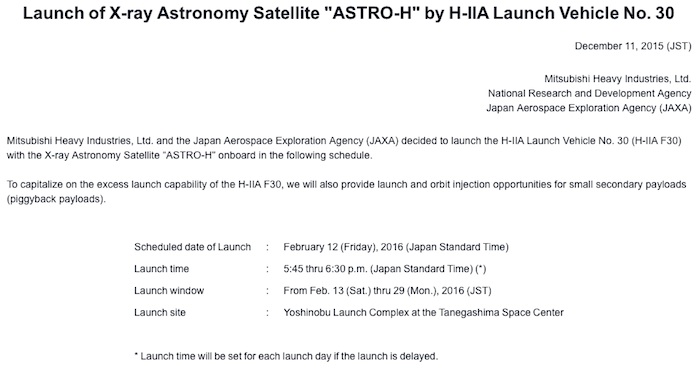
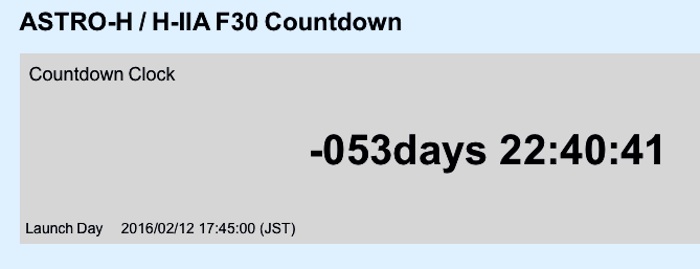
Quelle: JAXA
-
Update: 22.01.2016
.

Quelle: JAXA
-
Update: 7.02.2016
.
Japanese Telescope Will Give Canadians A New Eye on the Most Cataclysmic Events in the Universe
-
ASTRO-H, Japan's flagship astronomy mission, is slated for launch on Friday, February 12, 2016, at 3:45 a.m. (EST) / 12:45 a.m. (PST) from the Tanegashima Space Center in Japan.
The space observatory will be fitted with a unique laser measurement system, the Canadian ASTRO-H Metrology System (CAMS), provided by the Canadian Space Agency. In return for CAMS, Canadians will be part of the mission's science team and have privileged access to the space observatory to study black holes, supernova explosions, neutron stars, and how galaxies like our own Milky Way were formed. This precision optics technology was built by Neptec Design Group Ltd.
Astronaut and astrophysicist David Saint-Jacques; Professor Luigi Gallo, Canada's lead scientist from Saint Mary's University; and space industry experts from Neptec are available for interviews. Please contact the Canadian Space Agency to schedule
Quelle: Canadian Space Agency
---
Launch: February 12, 2016 at 3:45 a.m. (EST)/12:45 a.m. (PST) from the Tanegashima Space Center in Japan.
Status: Awaiting launch
New X-ray Eyes Will Reveal the Most Cataclysmic Events in the Cosmos
Imagine being able to peer into the innermost sanctums of monster-sized black holes and the remains of titanic explosions of stars. That is exactly the mission of ASTRO-H, an ambitious next-generation X-ray space telescope currently under development by the Japan Aerospace Exploration Agency (JAXA) with contributions from the United States, Europe and now Canada, through the Canadian Space Agency (CSA).
ASTRO-H will include five specialized X-ray telescopes and detectors. Together, those instruments will look at cosmic sources of X-rays at unprecedented resolution. With this superb sensitivity, ASTRO-H will explore the most energetic and mysterious phenomena in the Universe, involving particles at energies that can't be readily produced in Earth-based labs.
Canadian precision technology on board
Canada is involved in one of the spacecraft's key instruments, the Hard X-ray Telescope. It will be deployed at the end of a six-metre mast that is expected to twist and bend; this is due to on-orbit vibrations and the extreme day-night transitions the spacecraft will experience as it orbits the Earth at 550 km, where temperatures swing from -30 °C to +40 °C.
Recognizing Canadian expertise in space optical and vision systems, JAXA approached the CSA in 2009 to explore the possibility of Canada providing an innovative measurement system for the mission's Hard X-ray Telescope. Following a mission concept design phase, Neptec Design Group of Ottawa, Ontario, was awarded a CSA contract to develop a Canadian ASTRO-H Metrology System, or CAMS. CAMS will be able to precisely measure the mast's distortions to a level of accuracy equivalent to the width of two human hairs, allowing mission operators to calibrate the data of the Hard X-ray Telescope and significantly enhance the telescope's performance.
In return for this critical piece of hardware, Canada secures positions from Canadian institutions on the mission's Science Working Group, involving top scientists from around the world, notably from Japan, the US and Europe. Members of the group will be offered prime observing time on the space observatory soon after launch, for a period of approximately nine months. Data will then be made available to all scientists, including Canadian astronomers.
The CSA has selected three astronomers to represent Canada on the Science Working Group and support Canada's CAMS Project:
Dr. Luigi Gallo, Principal Investigator for ASTRO-H Metrology System, or CAMS, of Saint Mary's University;
Dr. Brian McNamara of the University of Waterloo; and
Dr. Samar Safi-Harb of the University of Manitoba.
The funding support provided by the CSA will allow these scientists to pursue advanced astronomical research with the ASTRO-H mission as well as participate in the International ASTRO-H Science Working Group meetings in Japan and in other parts of the world.
Leading-edge astronomy: Hunting down cosmic predators
ASTRO-H will peer down the throat of supermassive black holes that lurk at the heart of distant, young galaxies. Astronomers hope to get an unprecedented peek into the inner clockwork of the largest of these galactic predators that are billions of times more massive than our Sun.
ASTRO-H will also focus on unraveling the mysteries behind the remnants of star blasts known as supernovae. Astronomers believe that everything in the cosmos—even humans—was made from heavy elements forged in large part inside ancient supernovae. By using unmatched spectral resolution, combined with the ability to focus high-energy X-rays, ASTRO-H will make the most precise measurements ever obtained of the chemical ingredients that go into making these colossal cosmic explosions, and will probe the sites of particle acceleration to the highest energies.
According to the Canadian Principal Investigator for ASTRO-H mission, Dr. Luigi Gallo, this mission is a unique opportunity for Canada. ASTRO-H will mark the first time Canada is part of an X-ray astronomy mission that will explore the unseen Universe in unprecedented detail. Because of the CSA's contribution to ASTRO-H, "Canadian scientists get a chance to go to the front of the line in getting time to use this unique astronomical telescope," said Gallo, Professor of Astronomy at St. Mary's University, Halifax, Nova Scotia. "There is no doubt that we will be making big discoveries when it opens for business in three years' time."
Dr. Gallo will be making good use of his time on board ASTRO-H to study the ebb and flow in the X-rays belched out by the supermassive black holes. These fluctuations in the amount of X-rays are thought to be directly correlated to the amount of material being gobbled up by the black hole: any nearby stars, gas and dust clouds get swept up from the plane of the surrounding inner region of the galaxy. As matter is sucked in by the gravitational pull of the black hole, it gets torn apart and superheated, shooting radiation back out in space, which ASTRO-H will detect.
Astronomers believe early on in a galaxy's life, supermassive black holes sweep up most of the surrounding material in the galactic core. The black hole eventually quiets down as it runs out of cosmic things to eat; these voracious cosmic predators then calm down, allowing their host to become a normal galaxy (much like our own Milky Way).
ASTRO-H will be able to look at the very closest region around these giant black holes where the most intense X-ray radiations are being emitted. Not only will this give astronomers a clearer picture of how these cosmic predators evolve, but also how galaxies like our own came to be.
Dr. Samar Safi-Harb of the University of Manitoba will be investigating with ASTRO-H the high-energy phenomena associated with the supernova explosions of massive stars that form some of the most exotic compact objects in the Universe: neutron stars. These phenomena include particle acceleration of cosmic rays to extremely high energies, the formation of the heavy elements essential for life, and the physics of the extreme associated with neutron stars and their associated high-energy nebulae. Such studies will be enabled by ASTRO-H's combination of its broadband X-ray spectroscopic coverage, hard X-ray focusing capability, and the unprecedented spectral resolution offered by its X-ray micro-calorimeter.
Dr. Brian McNamara, Professor of Physics and Astronomy and University Research Chair in Astrophysics at the University of Waterloo, will use ASTRO-H to study powerful outbursts from massive black holes located at the centres of galaxy clusters. The energy released by matter falling onto supermassive black holes weighing more than one billion suns is equivalent to the mechanical energy of ten billion supernova explosions. This energy drives outflows of chemically enriched gas hundreds of thousands of light years into space. ASTRO-H will measure the mass and speed of the outflowing gas, allowing McNamara's team to determine the rate at which supermassive black holes are growing. The measurements will also help unravel the nature of the mysterious extragalactic "radio jets," which are streams of energetic particles flowing from the centres of galaxies at nearly the speed of light. ASTRO-H will advance our understanding of energetic feedback from supermassive black holes, an area in which Dr. McNamara is a recognized expert.
.
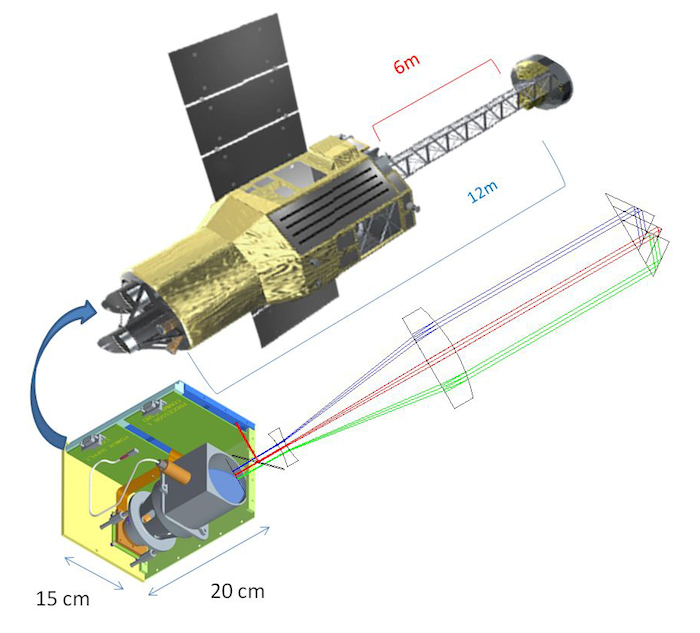
Illustration of ASTRO-H Metrology System, or CAMS onboard ASTRO-H. CAMS consists of two laser units (each approx. 15 cm cube) mounted on the satellite and a corner cube optical reflector installed at the end of the space observatory's 6 metre mast where the hard X-ray telescope sensors are located. The units fire laser onto the corner cube, which reflect the beam back into the unit where lateral displacements are measured down to a level of accuracy equivalent to the width of two human hairs. By comparing the measured lateral displacement on each sensor, the rotation about the telescope's main axis can be determined and the data acquired at the time of observation can be calibrated to a much higher level of accuracy than in the absence of the Canadian measurement system. (Credit: CSA)
Quelle: Canadian Space Agency
-
Update: 10.02.2016
.
New X-ray Space Observatory to Study Black Holes and History of Galaxy Clusters
Black hole enthusiasts, galaxy cluster aficionados, and X-ray astronomers have much to be excited about. On Friday, Feb. 12, the Japan Aerospace Exploration Agency (JAXA) will be launching their sixth satellite dedicated to X-ray astronomy, ASTRO-H, from the Tanegashima Space Center in Kagoshima, Japan. The observatory carries a state-of-the-art instrument and two telescope mirrors built at NASA's Goddard Space Flight Center in Greenbelt, Maryland. The launch is scheduled at 3:45 a.m. EST.
ASTRO-H is expected to provide breakthroughs in a wide variety of high-energy phenomena in the cosmos, ranging from the superheated material on the brink of falling into a black hole to the evolution of vast galaxy clusters. It is equipped with four advanced instruments covering a broad energy range, from low-energy, or "soft," X-rays around 300 electron volts (eV) to soft gamma rays up to 600,000 eV. For comparison, the energy of visible light spans about 2 to 3 eV.
.
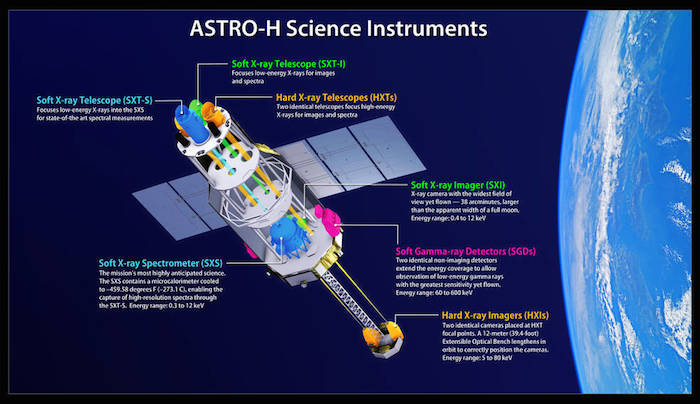
This illustration shows the locations and energy ranges of ASTRO-H science instruments and their associated telescopes. One keV equals 1,000 electron volts, which is hundreds of times the energy of visible light.
Credits: JAXA/NASA's Goddard Space Flight Center
Download additional images from NASA Goddard's Scientific Visualization Studio
"We see X-rays from sources throughout the universe, wherever the particles in matter reach sufficiently high energies," said Robert Petre, chief of Goddard's X-ray Astrophysics Laboratory and the U.S. project scientist for ASTRO-H. "These energies arise in a variety of settings, including stellar explosions, extreme magnetic fields, or strong gravity, and X-rays let us probe aspects of these phenomena that are inaccessible by instruments observing at other wavelengths."
ASTRO-H is capable of observing X-ray sources, like galaxy clusters and neutron stars, more than 10 times fainter than its predecessor, Suzaku, which operated from 2005 to 2015. To achieve this, ASTRO-H uses four co-aligned focusing X-ray telescopes and a suite of cutting-edge instruments that provide simultaneous coverage across the observatory's entire energy range.
-
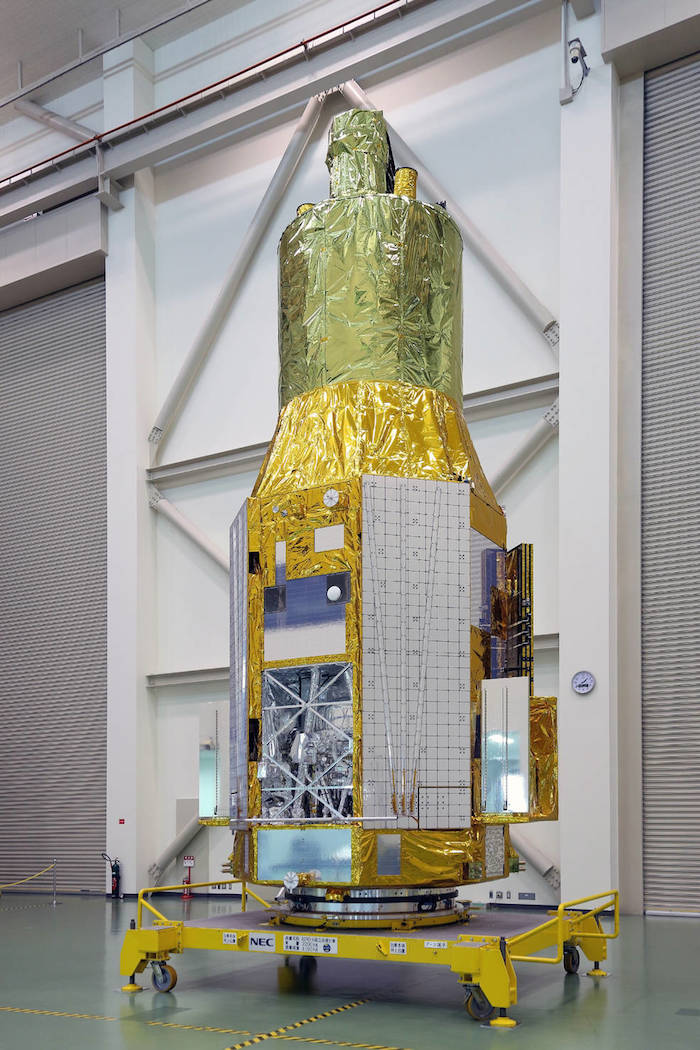
The ASTRO-H spacecraft as it appeared on Nov. 27, 2015, at Tsukuba Space Center in Japan. The open compartment visible at lower left houses the Soft X-ray Spectrometer.
Credits: JAXA
Two identical Soft X-ray Telescopes include mirror assemblies provided by the Goddard team. Because X-rays can penetrate matter, the mirrors rely on what scientists refer to as grazing incidence optics. Much like skipping a stone across water, X-ray light skimming the surface of curved mirror segments is deflected toward the telescope's focal point.
.
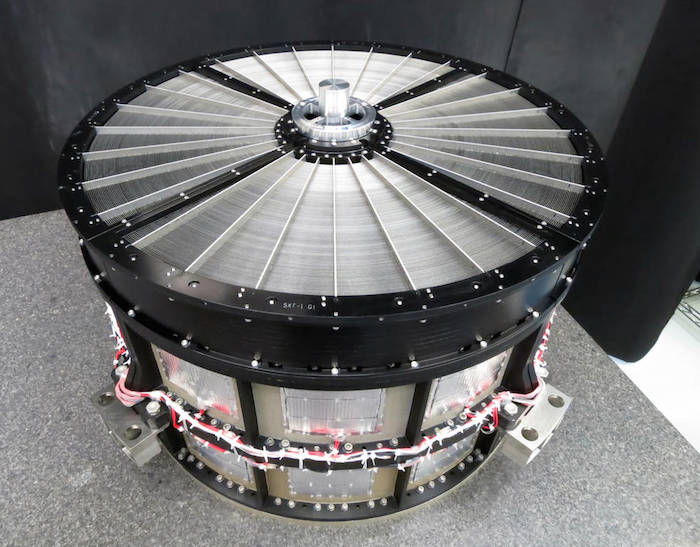
The Goddard team provided identical mirror assemblies for both of the Soft X-ray Telescopes aboard ASTRO-H. Each is 17.7 inches (45 centimeters) across and contains 1,624 precisely aligned aluminum mirror segments arranged in 203 concentric shells.
Credits: NASA's Goddard Space Flight Center
One Soft X-ray Telescope focuses light onto an advanced wide-field camera provided by Japan, while the other directs it into the Soft X-ray Spectrometer (SXS), an instrument developed and built by the Goddard team working closely with colleagues from several institutions in Japan. Astronomers typically learn about the composition, temperature and motions of cosmic sources by spreading out the wavelengths of light into a rainbow-like spectrum. But astrophysicists have devised an alternative approach for measuring X-ray "colors," called microcalorimetry, that produces unprecedented spectral resolution without diluting their intensity as happens in previously employed approaches.
.
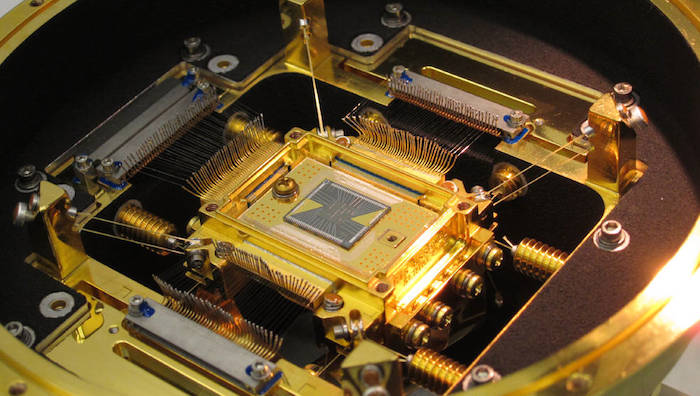
The heart of the ASTRO-H Soft X-ray Spectrometer is the microcalorimeter array at center. The five-millimeter square forms a 36-pixel array. Each pixel is 0.824 millimeter on a side, or about the width of the ball in a ballpoint pen. The detector's field of view is approximately three arcminutes, or one-tenth the apparent diameter of the full moon.
Credits: NASA's Goddard Space Flight Center
"This has been an extraordinary undertaking over many years to build this powerful new X-ray spectrometer jointly in the U.S. and Japan," said Goddard's Richard Kelley, the U.S. principal investigator for the ASTRO-H collaboration. "The international team is extremely excited to finally be able to apply the fundamentally new capabilities of the SXS, supported by the other instruments on the satellite, to observations of a wide range of celestial sources, especially clusters of galaxies and black hole systems."
Researchers in the U.S. pioneered the development of this revolutionary technology in the 1980s. ASTRO-H will provide astrophysicists with the first opportunity to use it on an orbiting X-ray observatory.
The SXS measures the heat generated when individual particles of light, called photons, strike the detector. The SXS precisely determines the energy of individual X-ray photons by measuring the small temperature increase made by each one. Because the changes are so small, the detector is cooled to -459.58 degrees Fahrenheit (-273.1 C) -- a fraction of a degree above absolute zero -- using a system developed in Japan and the U.S. Thanks to a series of nested vacuum containers called dewars, a supply of supercold liquid helium, and a sequence of mechanical and magnetic refrigerators, the SXS is expected to keep its cool for more than three years.
"The technology used in the SXS is leading the way to the next generation of imaging X-ray spectrometers, which will be able to distinguish tens of thousands of X-ray colors while capturing sharp images at the same time," said Caroline Kilbourne, a member of the Goddard SXS team.
The observatory also carries two identical Hard X-ray Telescopes and their associated cameras, which image light from 5,000 to 80,000 eV, and two Soft Gamma-ray Detectors, which are sensitive to light from 60,000 to 600,000 eV but do not produce images. Both the telescopes and the instruments were provided by Japan.
ASTRO-H was developed by the Institute of Space and Astronautical Science, a division of JAXA. It was built jointly by an international collaboration led by JAXA, with contributions from NASA Goddard and other institutions in Japan, Canada and Europe. Additional Goddard responsibilities included development of the analysis software and data processing pipeline and creation of a facility to support a vigorous guest observer program enabling the participation of the broader U.S. science community in the mission.
Quelle: NASA
-
Update: 11.02.2016
.

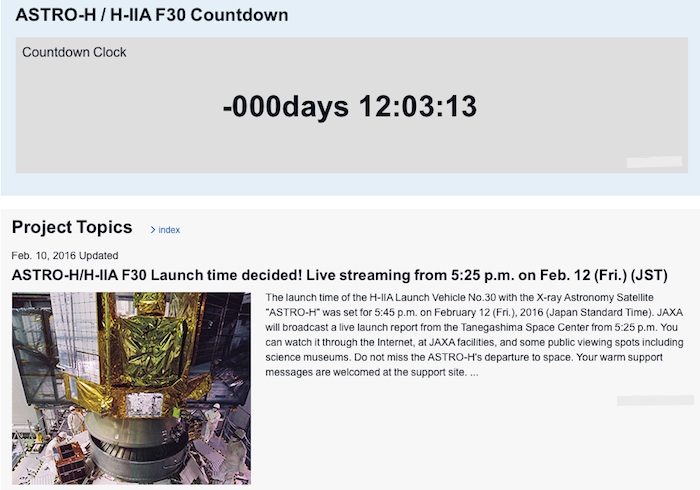
Quelle: JAXA
-
Update: 12.02.2016
.
Weather forces JAXA to scrub launch of H-IIA rocket carrying X-ray astronomy satellite
.
FEB 12, 2016
-
The launch of a rocket carrying a new X-ray astronomy satellite has been postponed from the initially planned Friday due to bad weather, Mitsubishi Heavy Industries Ltd. said Thursday.
A new liftoff date has not been set, said Mitsubishi Heavy, the builder and operator of the rocket. The launch had been planned for 5:45 p.m. Friday at the Tanegashima Space Center in Kagoshima Prefecture.
The 30th H-IIA rocket plans to put into orbit the Astro-H satellite, a space observatory equipped with four X-ray telescopes and two gamma-ray detectors.
Scientists hope to observe distant black holes and galaxies with it to study the mysteries surrounding the evolution of the universe.
The satellite was developed by the Japan Aerospace Exploration Agency and other organizations, such as the U.S. National Aeronautics and Space Administration, with the participation of more than 200 researchers at home and abroad.
The cylindrical fuselage measures 14 meters long and weighs 2.7 tons, the heaviest among the scientific satellites Japan has worked on.
It will be a successor to JAXA’s other X-ray astronomy satellite named Suzaku, which ceased its operations last year. Compared with its predecessor, Astro-H boasts 10-100 times more sensitivity, according to the space agency.
Quelle: The Japan Times
---

Quelle: JAXA
-
Update: 14.02.2016
.
Launch Date and Time of X-ray Astronomy Satellite (ASTRO-H)
by H-IIA Launch Vehicle No. 30
February 14, 2016 (JST)
Mitsubishi Heavy Industries, Ltd.
National Research and Development Agency
Japan Aerospace Exploration Agency (JAXA)
Mitsubishi Heavy Industries, Ltd. and the Japan Aerospace Exploration Agency (JAXA) decided to conduct the launch of the H-IIA Launch Vehicle No.30 with the X-ray Astronomy Satellite (ASTRO-H) onboard from the Tanegashima Space Center as follows.
Scheduled date of launch: February 17 (Wed.), 2016 (Japan Standard Time, JST)
Launch time: 5:45 p.m. (JST)
Launch window: 5:45 thru 6:30 p.m. (JST)
The launch, originally scheduled for February 12, 2016 (JST), had been postponed due to adversary weather conditions.
Please note that the launch date may be delayed further due to weather conditions.
Quelle: JAXA
-
Update: 15.02.2016
.
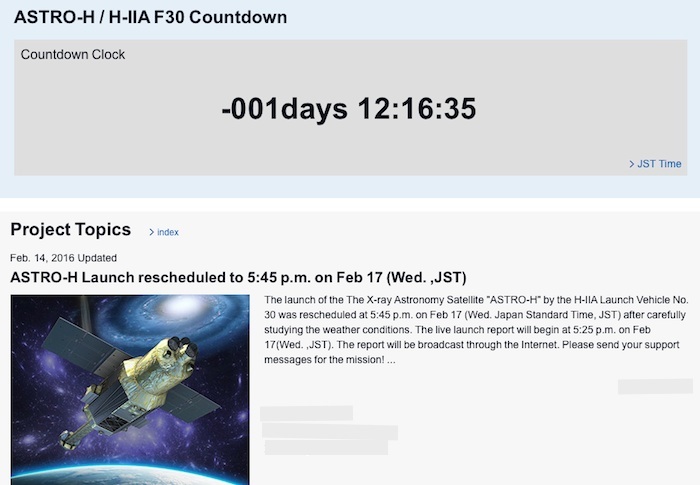
Quelle: JAXA
-
Update: 17.02.2016
.
Start von JAXA´s X-ray ASTRO-H Satelliten LIVE
...8.24 MEZ:
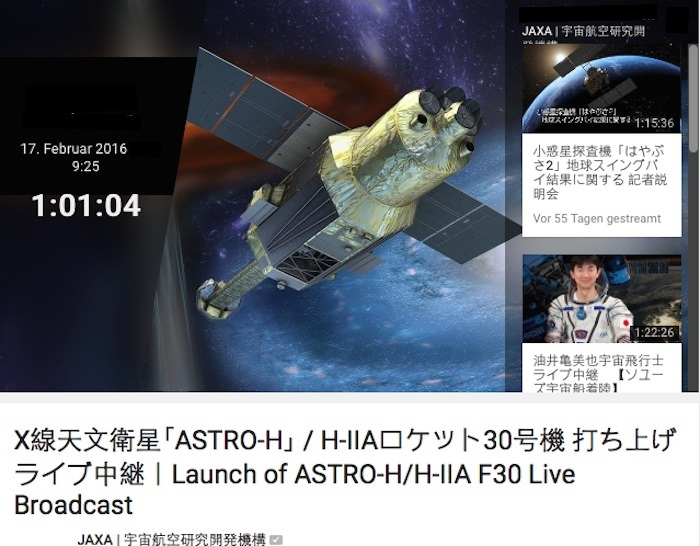
Quelle: JAXA
...8.40 MEZ
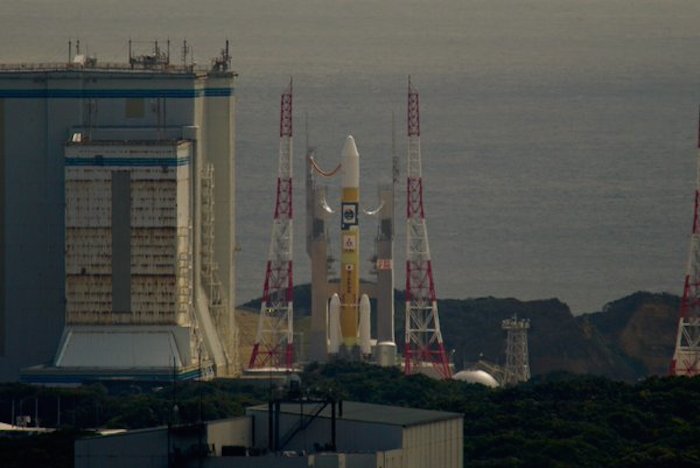
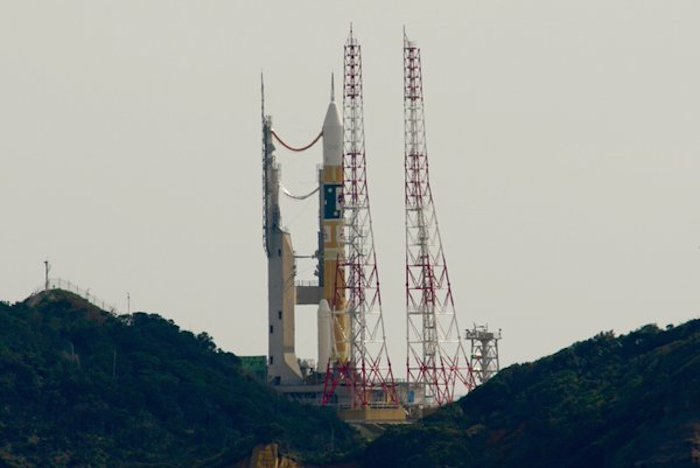
...9.15 MEZ
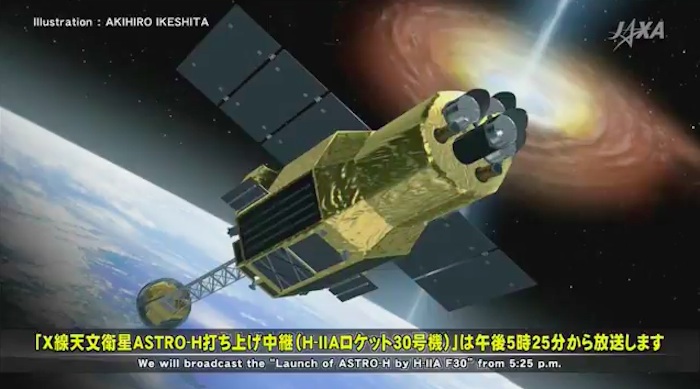
...9.25 MEZ
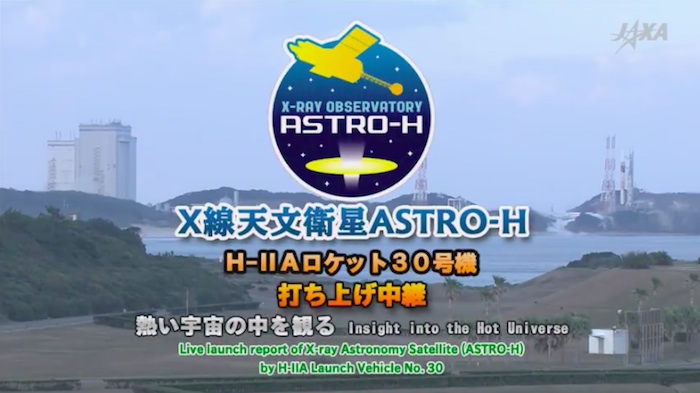
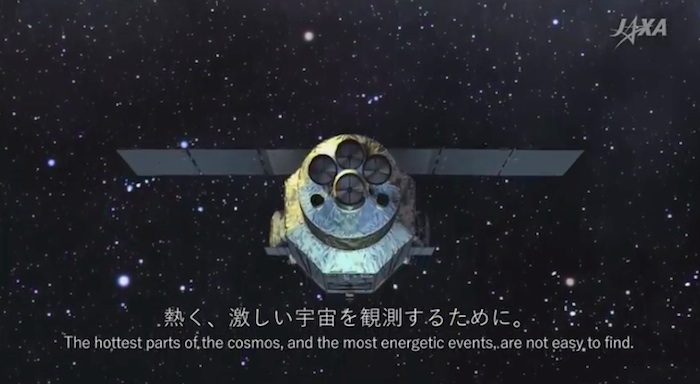
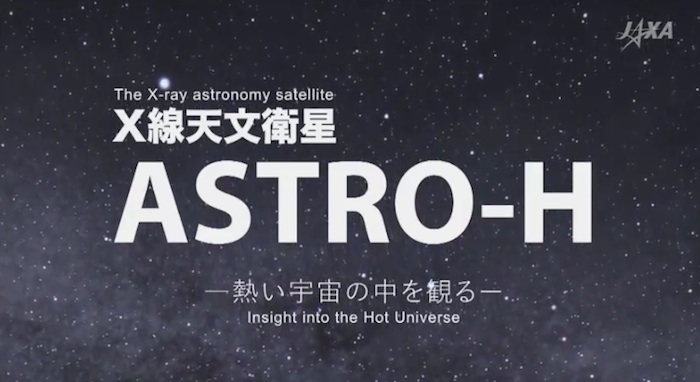
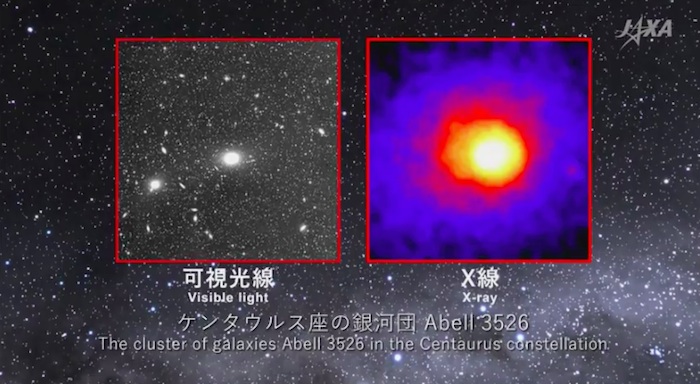
...9.46 MEZ
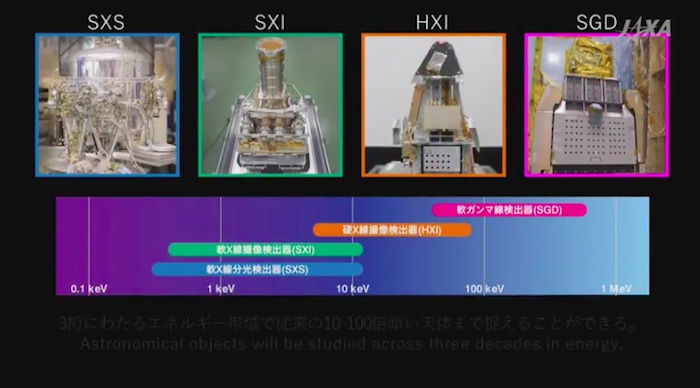
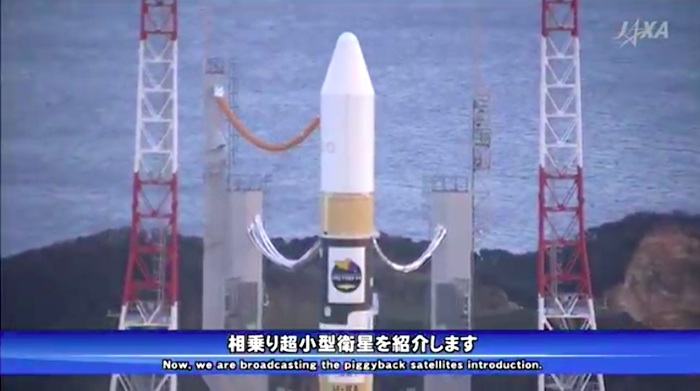
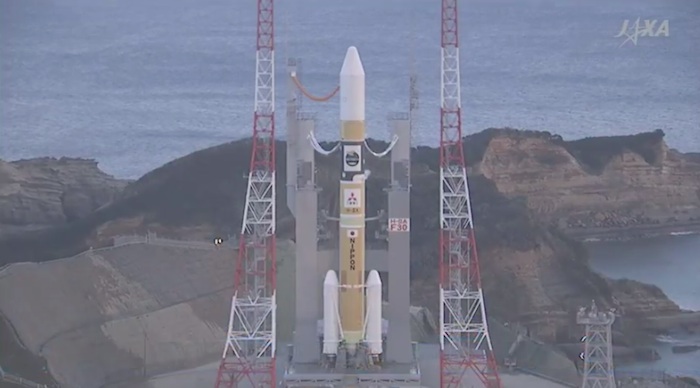

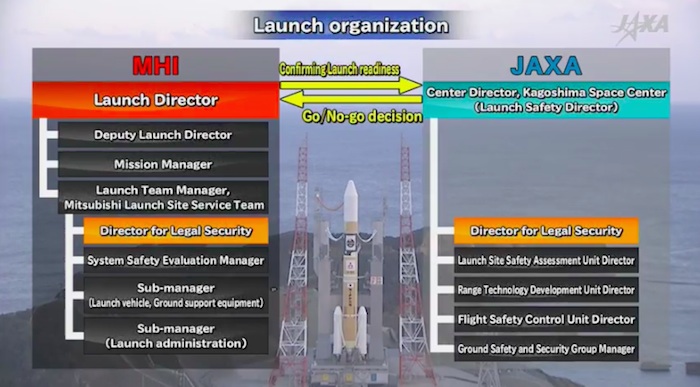
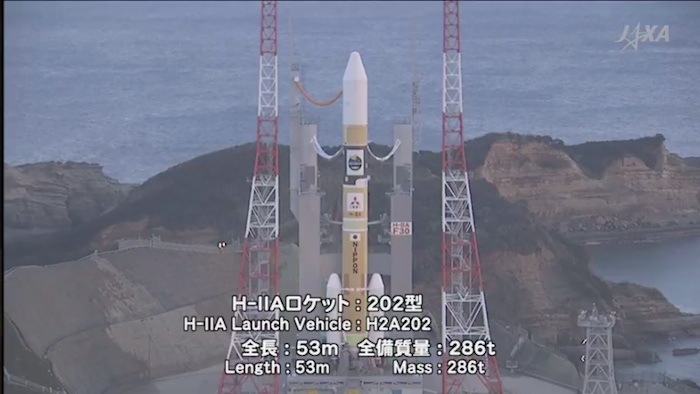
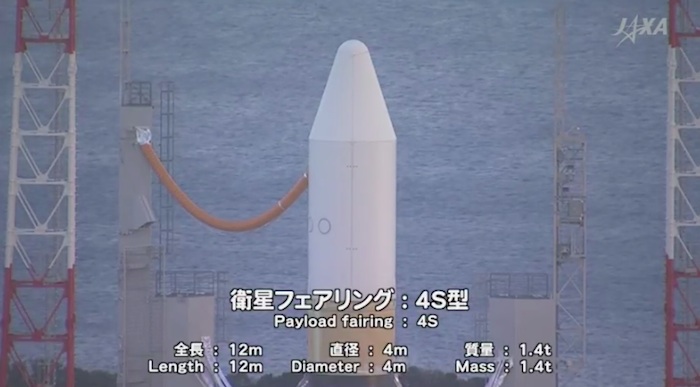
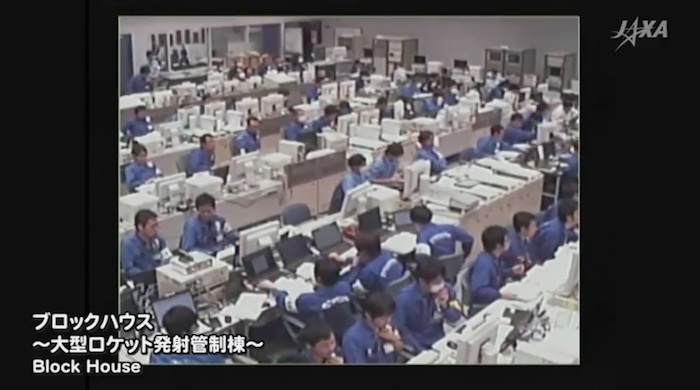
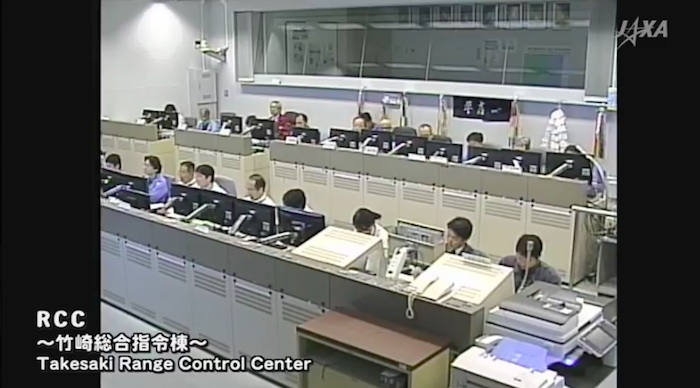
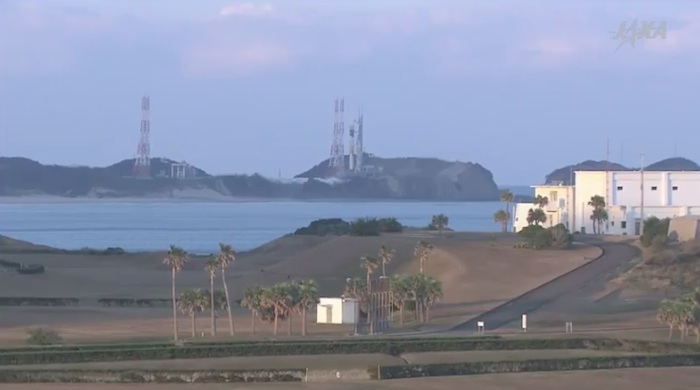
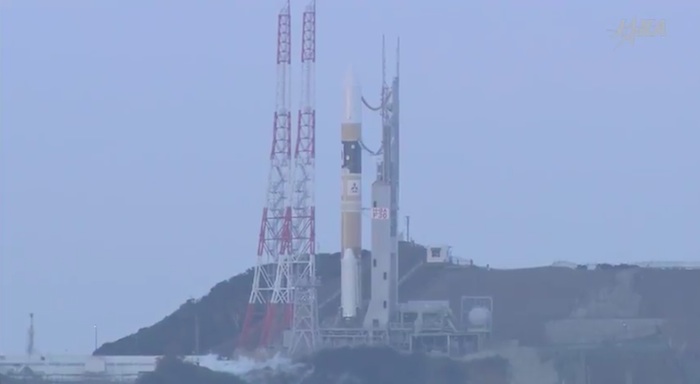
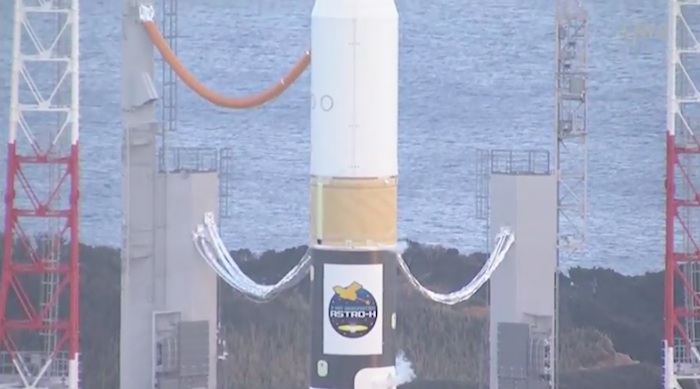
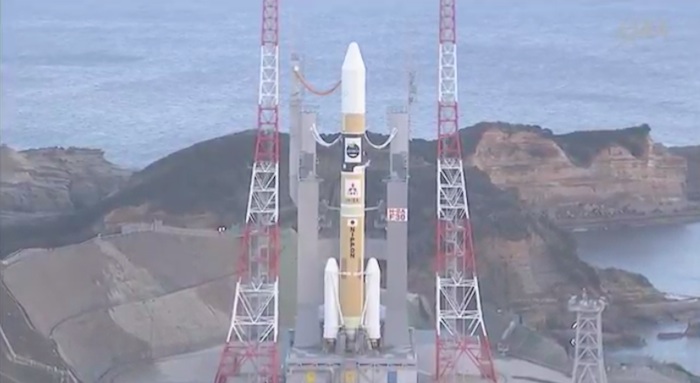
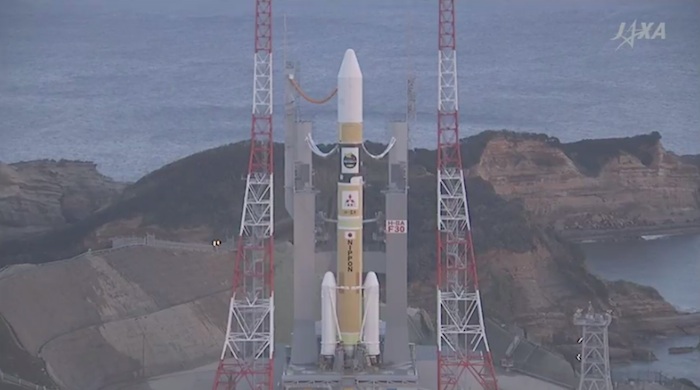
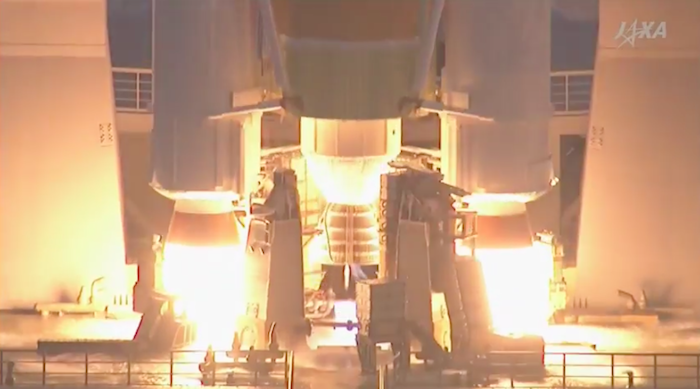
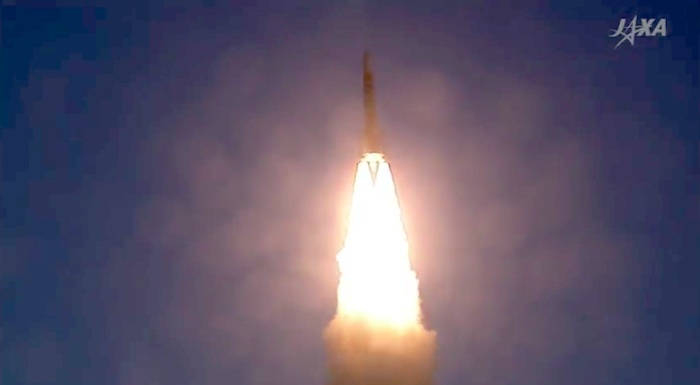
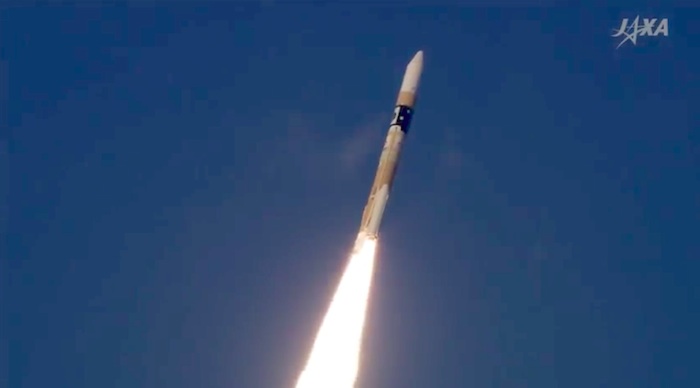
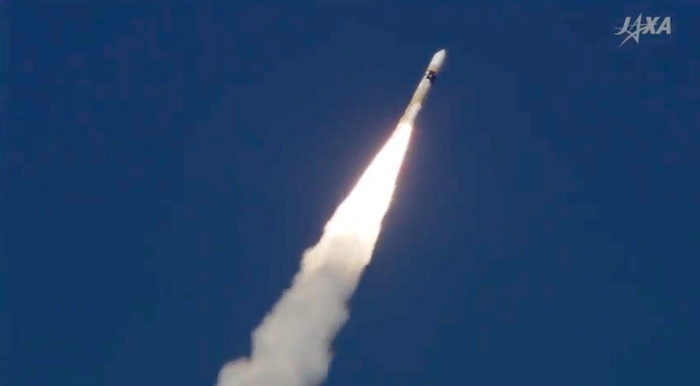

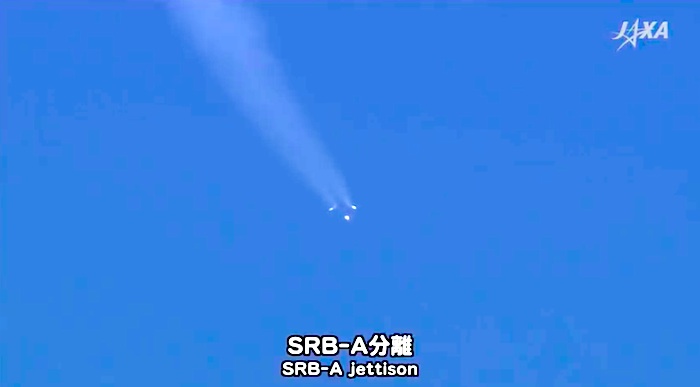
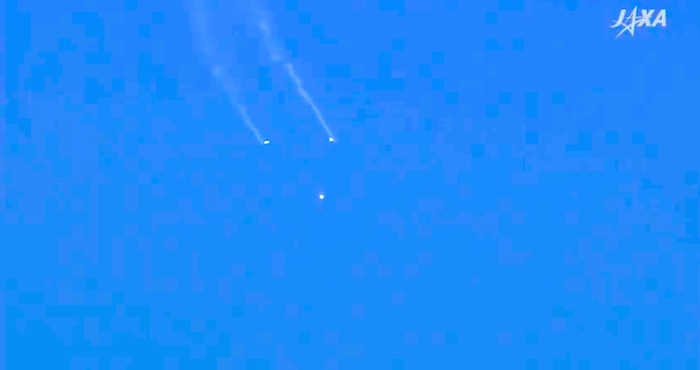
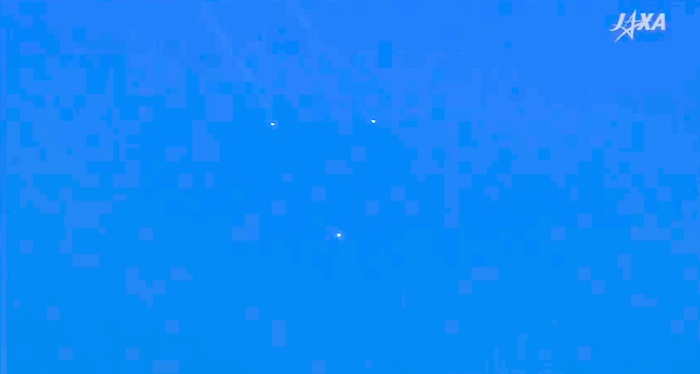
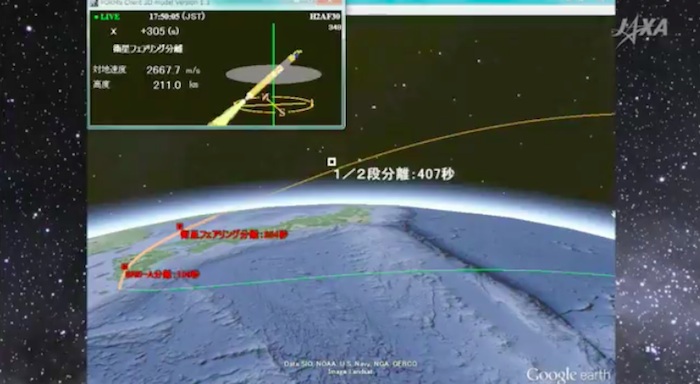
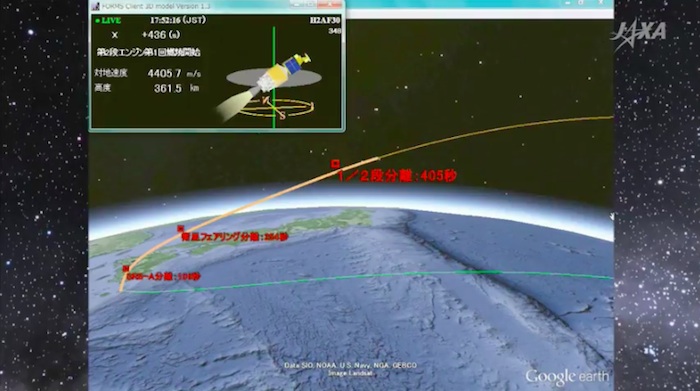
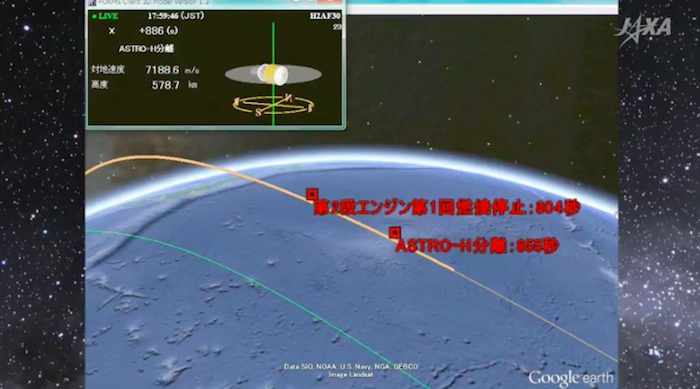
Quelle: JAXA
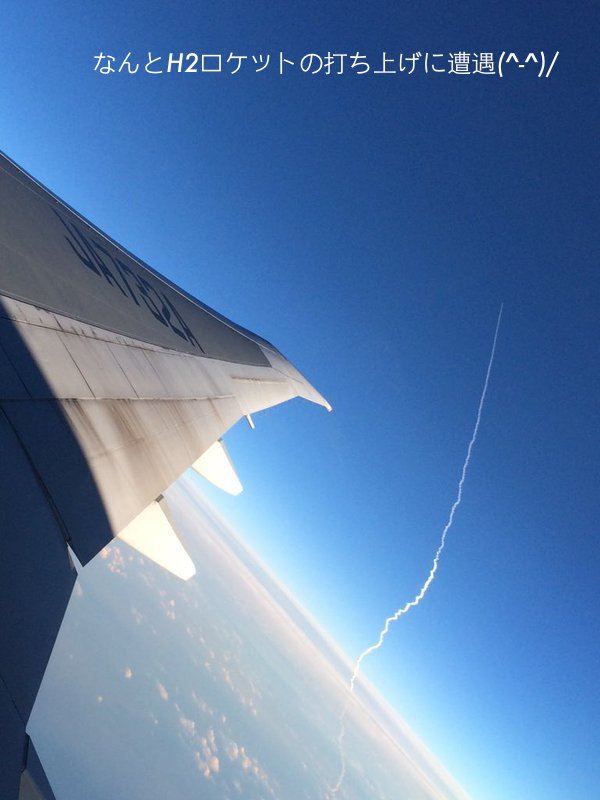
-
Update: 18.02.2016
.
JAXA names new orbiting X-ray astronomy satellite ‘the Eye’
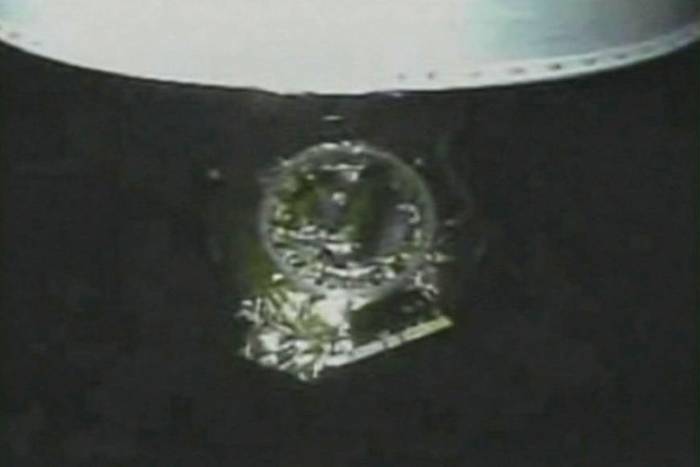
The Hitomi X-ray astronomy satellite is seen detached from an H-IIA rocket after being launched Wednesday from the Tanegashima Space Center in Kagoshima Prefecture. | JAXA/KYODO
-
Japan’s space agency has named an X-ray astronomy satellite that was successfully launched into space Wednesday the Hitomi (Eye), with scientists hoping the new equipment will help their quest to observe distant black holes and galaxies.
The satellite, also called the Astro-H, was put into space on an H-IIA rocket that lifted off from the Tanegashima Space Center in Kagoshima Prefecture.
The two-stage booster lifted off at 5:45 p.m., delivering the Astro-H satellite about 15 minutes later into orbit, according to the Japan Aerospace Exploration Agency.
With the successful launch, JAXA gave the new name to the satellite Wednesday evening.
The satellite is 14 meters long and weighs 2.7 tons, and is equipped with four X-ray telescopes and two gamma-ray detectors.
Starting this summer after preparations are completed, JAXA will fully operate the Hitomi satellite over the next three years. The joint project with NASA has cost some ¥39 billion, with JAXA shouldering ¥31 billion.
The launch was initially scheduled for last Friday but was postponed to Wednesday due to bad weather.
Quelle: The Japan Times
4799 Views
